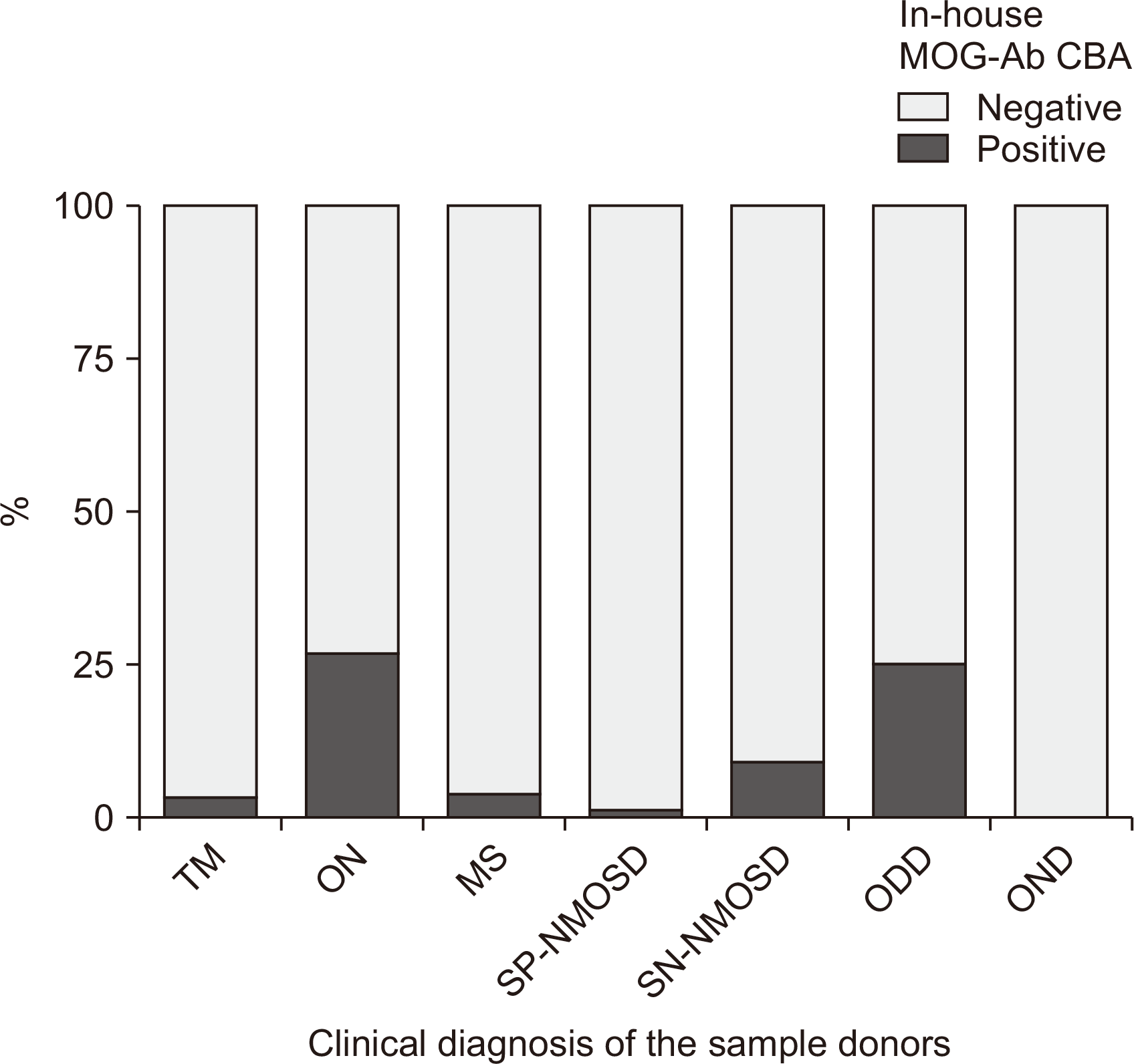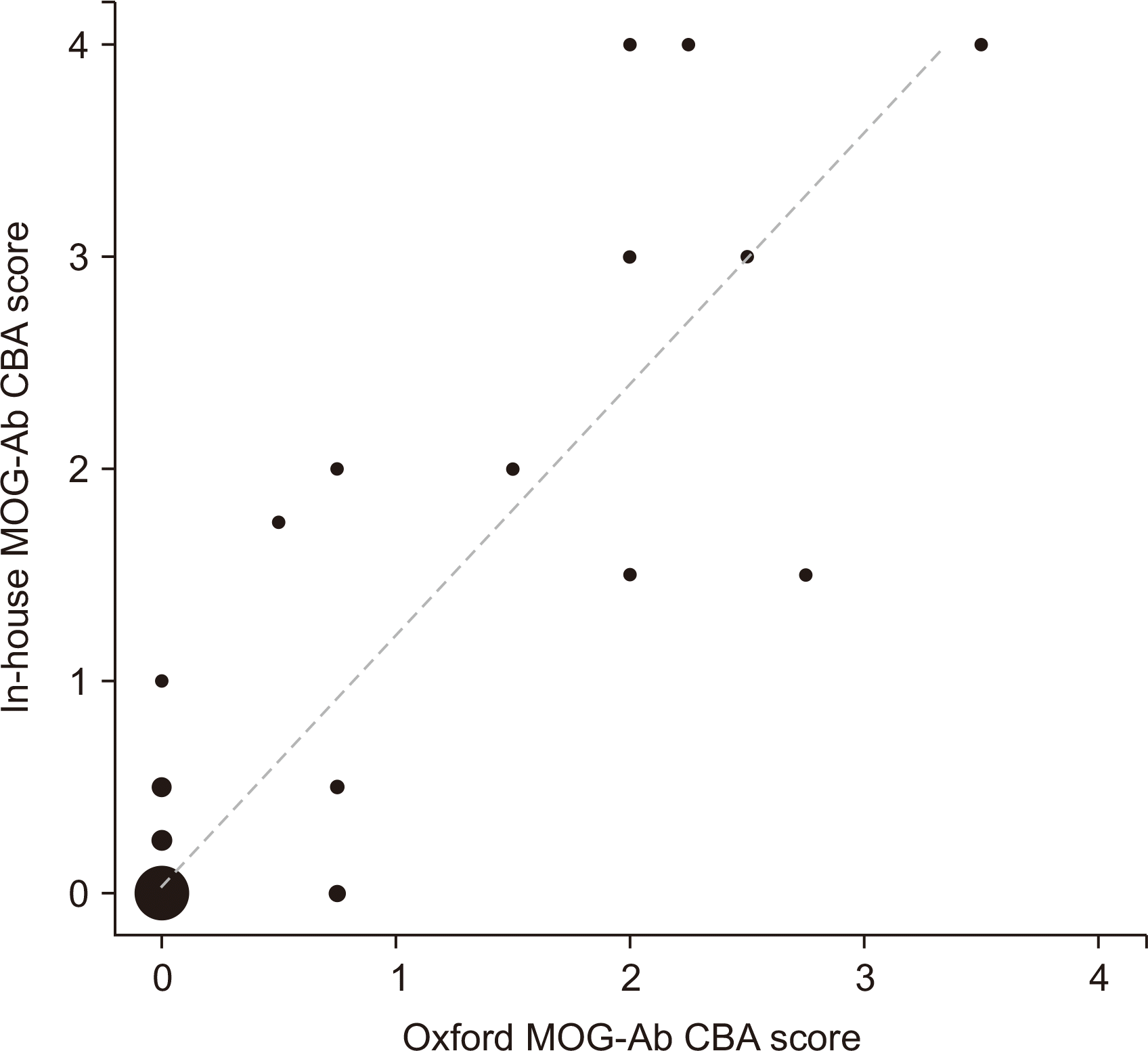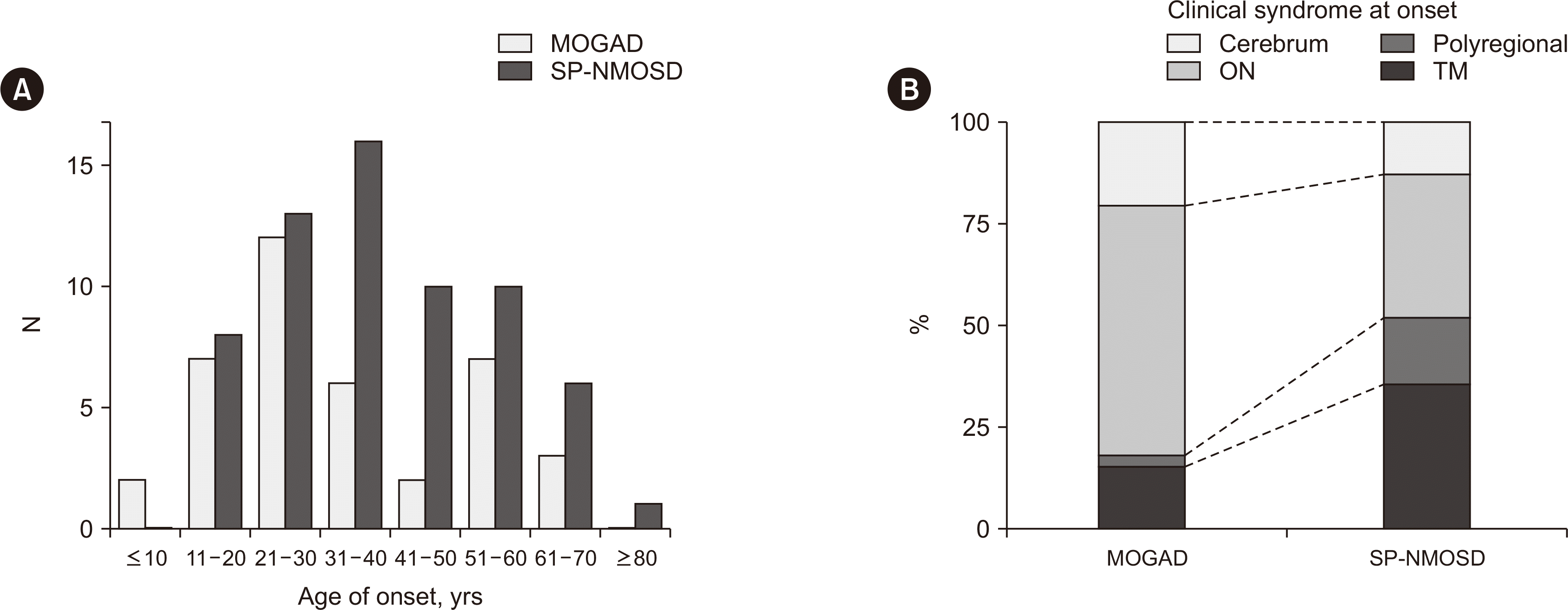2. Wingerchuk DM, Banwell B, Bennett JL, Cabre P, Carroll W, Chitnis T, et al. 2015; International consensus diagnostic criteria for neuromyelitis optica spectrum disorders. Neurology. 85:177–89. DOI:
10.1212/WNL.0000000000001729. PMID:
26092914. PMCID:
PMC4515040.

3. Jeyalatha MV, Therese KL, Anand AR. 2022; An update on the laboratory diagnosis of neuromyelitis optica spectrum disorders. J Clin Neurol. 18:152–62. DOI:
10.3988/jcn.2022.18.2.152. PMID:
35274835. PMCID:
PMC8926771.

4. Jarius S, Paul F, Aktas O, Asgari N, Dale RC, de Seze J, et al. 2018; MOG encephalomyelitis: international recommendations on diagnosis and antibody testing. J Neuroinflammation. 15:134. DOI:
10.1186/s12974-018-1144-2. PMID:
29724224. PMCID:
PMC5932838.

5. de Mol CL, Wong Y, van Pelt ED, Wokke B, Siepman T, Neuteboom RF, et al. 2020; The clinical spectrum and incidence of anti-MOG-associated acquired demyelinating syndromes in children and adults. Mult Scler. 26:806–14. DOI:
10.1177/1352458519845112. PMID:
31094288. PMCID:
PMC7294530.

6. Kim KH, Kim SH, Hyun JW, Kim HJ. 2022; Clinical and radiological features of myelin oligodendrocyte glycoprotein-associated myelitis in adults. J Clin Neurol. 18:280–9. DOI:
10.3988/jcn.2022.18.3.280. PMID:
35589317. PMCID:
PMC9163942.

7. Akaishi T, Takahashi T, Misu T, Kaneko K, Takai Y, Nishiyama S, et al. 2021; Difference in the source of anti-AQP4-IgG and anti-MOG-IgG antibodies in CSF in patients with neuromyelitis optica spectrum disorder. Neurology. 97:e1–12. DOI:
10.1212/WNL.0000000000012175. PMID:
33980704. PMCID:
PMC8312856.

8. Sechi E, Krecke KN, Pittock SJ, Dubey D, Lopez-Chiriboga AS, Kunchok A, et al. 2021; Frequency and characteristics of MRI-negative myelitis associated with MOG autoantibodies. Mult Scler. 27:303–8. DOI:
10.1177/1352458520907900. PMID:
32103708. PMCID:
PMC7500857.

9. Cobo-Calvo A, Ruiz A, Rollot F, Arrambide G, Deschamps R, Maillart E, et al. 2021; Clinical features and risk of relapse in children and adults with myelin oligodendrocyte glycoprotein antibody-associated disease. Ann Neurol. 89:30–41. DOI:
10.1002/ana.25909. PMID:
32959427.

10. Hyun JW, Lee HL, Jeong WK, Lee HJ, Shin JH, Min JH, et al. 2021; Comparison of MOG and AQP4 antibody seroprevalence in Korean adults with inflammatory demyelinating CNS diseases. Mult Scler. 27:964–7. DOI:
10.1177/1352458520948213. PMID:
32779521.

11. Polman CH, Reingold SC, Banwell B, Clanet M, Cohen JA, Filippi M, et al. 2011; Diagnostic criteria for multiple sclerosis: 2010 revisions to the McDonald criteria. Ann Neurol. 69:292–302. DOI:
10.1002/ana.22366. PMID:
21387374. PMCID:
PMC3084507.

12. Thompson AJ, Banwell BL, Barkhof F, Carroll WM, Coetzee T, Comi G, et al. 2018; Diagnosis of multiple sclerosis: 2017 revisions of the McDonald criteria. Lancet Neurol. 17:162–73. DOI:
10.1016/S1474-4422(17)30470-2. PMID:
29275977.

13. Waters P, Woodhall M, O'Connor KC, Reindl M, Lang B, Sato DK, et al. 2015; MOG cell-based assay detects non-MS patients with inflammatory neurologic disease. Neurol Neuroimmunol Neuroinflamm. 2:e89. DOI:
10.1212/NXI.0000000000000089. PMID:
25821844. PMCID:
PMC4370386.
14. Waters PJ, Komorowski L, Woodhall M, Lederer S, Majed M, Fryer J, et al. 2019; A multicenter comparison of MOG-IgG cell-based assays. Neurology. 92:e1250–5. DOI:
10.1212/WNL.0000000000007096. PMID:
30728305. PMCID:
PMC6511109.

15. Kang ES, Min JH, Lee KH, Kim BJ. 2012; Clinical usefulness of cell-based indirect immunofluorescence assay for the detection of aquaporin-4 antibodies in neuromyelitis optica spectrum disorder. Ann Lab Med. 32:331–8. DOI:
10.3343/alm.2012.32.5.331. PMID:
22950068. PMCID:
PMC3427820.

16. Fujihara K, Cook LJ. 2020; Neuromyelitis optica spectrum disorders and myelin oligodendrocyte glycoprotein antibody-associated disease: current topics. Curr Opin Neurol. 33:300–8. DOI:
10.1097/WCO.0000000000000828. PMID:
32374571.

17. Lee HJ, Kim B, Waters P, Woodhall M, Irani S, Ahn S, et al. 2018; Chronic relapsing inflammatory optic neuropathy (CRION): a manifestation of myelin oligodendrocyte glycoprotein antibodies. J Neuroinflammation. 15:302. DOI:
10.1186/s12974-018-1335-x. PMID:
30382857. PMCID:
PMC6208174.

18. Hamid SHM, Whittam D, Mutch K, Linaker S, Solomon T, Das K, et al. 2017; What proportion of AQP4-IgG-negative NMO spectrum disorder patients are MOG-IgG positive? A cross sectional study of 132 patients. J Neurol. 264:2088–94. DOI:
10.1007/s00415-017-8596-7. PMID:
28840314. PMCID:
PMC5617862.

19. Reindl M, Di Pauli F, Rostásy K, Berger T. 2013; The spectrum of MOG autoantibody-associated demyelinating diseases. Nat Rev Neurol. 9:455–61. DOI:
10.1038/nrneurol.2013.118. PMID:
23797245.

20. Cao Y, Xu J, Yi Z, Zhou L. 2023; A case of MOGAD complicated with cerebral vasculitis: case report and literature review. J Clin Neurol. 19:96–8. DOI:
10.3988/jcn.2023.19.1.96. PMID:
36606653. PMCID:
PMC9833881.

21. Jurynczyk M, Messina S, Woodhall MR, Raza N, Everett R, Roca-Fernandez A, et al. 2017; Clinical presentation and prognosis in MOG-antibody disease: a UK study. Brain. 140:3128–38. DOI:
10.1093/brain/awx276. PMID:
29136091.

22. Kunchok A, Chen JJ, McKeon A, Mills JR, Flanagan EP, Pittock SJ. 2020; Coexistence of myelin oligodendrocyte glycoprotein and aquaporin-4 antibodies in adult and pediatric patients. JAMA Neurol. 77:257–9. DOI:
10.1001/jamaneurol.2019.3656. PMID:
31657826. PMCID:
PMC6820046.

23. Kim SM, Woodhall MR, Kim JS, Kim SJ, Park KS, Vincent A, et al. 2015; Antibodies to MOG in adults with inflammatory demyelinating disease of the CNS. Neurol Neuroimmunol Neuroinflamm. 2:e163. DOI:
10.1212/NXI.0000000000000163. PMID:
26516628. PMCID:
PMC4608758.

24. Lee HL, Kim SH, Seok JM, Kim BJ, Kim HJ, Kim BJ. 2022; Results of a survey on diagnostic procedures and treatment choices for neuromyelitis optica spectrum disorder in Korea: beyond the context of current clinical guidelines. J Clin Neurol. 18:207–13. DOI:
10.3988/jcn.2022.18.2.207. PMID:
35274837. PMCID:
PMC8926765.

25. Gastaldi M, Scaranzin S, Jarius S, Wildeman B, Zardini E, Mallucci G, et al. 2020; Cell-based assays for the detection of MOG antibodies: a comparative study. J Neurol. 267:3555–64. DOI:
10.1007/s00415-020-10024-0. PMID:
32623596.

26. Reindl M, Schanda K, Woodhall M, Tea F, Ramanathan S, Sagen J, et al. 2020; International multicenter examination of MOG antibody assays. Neurol Neuroimmunol Neuroinflamm. 7:e674. DOI:
10.1212/NXI.0000000000000674. PMID:
32024795. PMCID:
PMC7051197.

27. Lui A, Chong J, Flanagan E, Abrams AW, Krysko KM, Arikan B, et al. 2021; High titers of myelin oligodendrocyte glycoprotein antibody are only observed close to clinical events in pediatrics. Mult Scler Relat Disord. 56:103253. DOI:
10.1016/j.msard.2021.103253. PMID:
34517190. PMCID:
PMC8678350.
28. Cobo-Calvo A, Sepúlveda M, d'Indy H, Armangué T, Ruiz A, Maillart E, et al. 2019; Usefulness of MOG-antibody titres at first episode to predict the future clinical course in adults. J Neurol. 266:806–15. DOI:
10.1007/s00415-018-9160-9. PMID:
30607536.

29. van Pelt ED, Wong YYM, Ketelslegers IA, Hamann D, Hintzen RQ. 2016; Neuromyelitis optica spectrum disorders: comparison of clinical and magnetic resonance imaging characteristics of AQP4-IgG versus MOG-IgG seropositive cases in the Netherlands. Eur J Neurol. 23:580–7. DOI:
10.1111/ene.12898. PMID:
26593750.

30. Hyun JW, Kim Y, Kim KH, Kim SH, Olesen MN, Asgari N, et al. 2022; CSF GFAP levels in double seronegative neuromyelitis optica spectrum disorder: no evidence of astrocyte damage. J Neuroinflammation. 19:86. DOI:
10.1186/s12974-022-02450-w. PMID:
35413922. PMCID:
PMC9006458.

31. Sepúlveda M, Armangué T, Sola-Valls N, Arrambide G, Meca-Lallana JE, Oreja-Guevara C, et al. 2016; Neuromyelitis optica spectrum disorders: comparison according to the phenotype and serostatus. Neurol Neuroimmunol Neuroinflamm. 3:e225. DOI:
10.1212/NXI.0000000000000225. PMID:
27144216. PMCID:
PMC4841645.
32. Banwell B, Bennett JL, Marignier R, Kim HJ, Brilot F, Flanagan EP, et al. 2023; Diagnosis of myelin oligodendrocyte glycoprotein antibody-associated disease: International MOGAD Panel proposed criteria. Lancet Neurol. 22:268–82. DOI:
10.1016/S1474-4422(22)00431-8. PMID:
36706773.









 PDF
PDF Citation
Citation Print
Print



 XML Download
XML Download